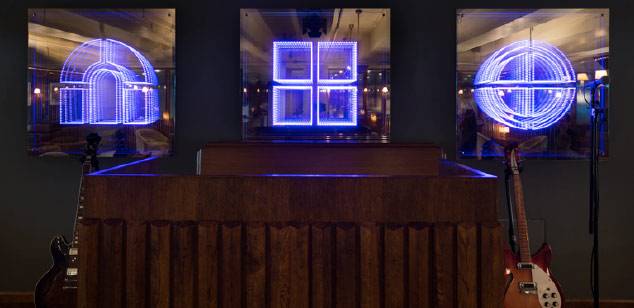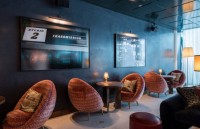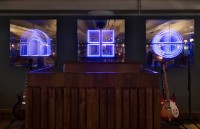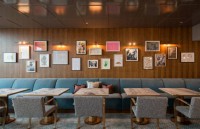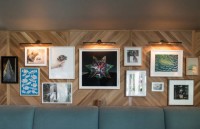Project Description
White City House, London
A cultural icon and landmark piece of modern architecture, the Television Centre at White City was a factory for television and a powerhouse of creative broadcasting. Soho House opened a new site, White City House, as part of the redevelopment complex in April 2018. The art collection is dedicated to honouring the creative spirit and enduring broadcasting legacy of this important location.
A key aspect of this collections is Dear Tony Hart, a commissioned collection that honours the BBC Television Artist Tony Hart (1925-2009) who inspired many generations throughout his 50-year broadcasting history. His programmes, Vision On, Take Hart and Hart Beat encouraged children to send in their artwork for selection and display on the television, the artwork was never returned but successful young artists would receive a book token. I was fascinated to discover that Michael Landy not only succeeded in showcasing his childhood artwork in Vision On, but kept the rewarding book token into adulthood until it was later destroyed in his landmark artwork, Break Down in 2001. Dear Tony Hart collection features all new work from 19 contemporary artists and is permanently installed on one large wall in the main club space.
Highlights include 3 works pre-dating the artist’s professional careers: a drawing from the youth of Sue Webster (a portrait of her parents she created aged 8 in 1975); teenage Mat Collishaw’s abstracted painting of his groin L’Homme Bleu 1984; Michael Landy’s decorative motif titled Michael Landy aged 54 Take Hart Scraperboard, 1979-2018. Thomas Heatherwick, another huge Tony Hart fan, presents a small maquette for his sculptural cooling vents (2002) outside St Paul’s cathedral, London. Ryan Gander based his piece on the original obituary he was commissioned to write about Tony Hart for Frieze magazine in 2009, Validation through association, or, To give voice’.
‘On Television’ is another sub-collection, largely displayed across the public ground floor. The artworks playfully, obliquely and sometimes boldly reference iconic television programmes such as Roundabout (Ivan Seal), Blue Peter (George Henry Longly), Rainbow (David Shrigley), Top of the Pops (David Koppel, Janet Milner, Kate Gibb, Matthew Rich) and concerts (Adam Dix) as well as soap operas (Julian Rosefeldt) and the famous colourful test card image, as appropriated in a contemporary glass work by young British artist Archie Proudfoot. A key commission for the site was a series of 4 editions from the pop artist Peter Blake. His signature collage work shows a line-up of broadcast stars throughout the past 5 decades assembled outside Television Centre. These works are displayed across the bedrooms of the club.
The television references extend into the main floor of the club, alongside Dear Tony Hart are two key site-specific installations by the light artist Chris Levine and the photographer Mary McCartney.
The site was pioneering in both architectural design and content from its inception in the 1950s. The interior design of White City House pays homage to the great heyday of British modernism and the art on the main club floor has a distinct emphasis on British abstraction and the clean lines of modernism seen through a contemporary lens. Key pieces include a large semi-circular painting by Berlin based artist Claudia Comte and a sculpture with evokes the days of smoking on TV by Nicole Wermers.
The 8th floor of the House is a dedicated events space and the art collection is themed on the idea of outer space. For the night of the Moon landing, the BBC made British TV history by screening the nation’s first all night broadcasts, remaining on air for 11 hours from 11.30pm, July 20th to 10.30am, July 21st. In total, the BBC featured 27 hours of coverage of the Apollo 11 mission over 10 days, from July 16th – 24th, across BBC1 and BBC2. The artworks selected for this floor all pay homage to this key broadcasting endeavour with works by Kathleen Herbert, UVA, Sarah Jones, Richard Wright and Mark Dean.
A small cabana on the roof plays host to a small but important part of the art collection that reminds us of the brilliance of natural world broadcasting. No other man has seen as much of the globe, nor brought so much of it into our living rooms as Sir David Attenborough. The works all speak to the natural world and includes pieces from Australian eco-activist artist Janet Laurence as well as Hugo Wilson and Polly Morgan.
PRESS & REVIEWS
A first look at White City House members’ club in London’s iconic Television Centre.
White City House has been installed in West London’s Television Centre. Architect Graham Dawbarn’s iconic construction, which encircles a statue of Helios, was BBC’s home from 1960 to 2013. In the three-floor club area as well as in the 45 bedrooms, there’s a 1950s vibe with accents that include oakwood walls and terrazzo-tile floors.
There were so few channels back then, that television was central to everybody’s cultural experience,” adds Bryan. “You could go into school the next day and everyone would have watched the same thing. The impression those programmes made on you was indelible. For a lot of people, it was all about Top of the Pops, but if you say to any artist, ‘What did you watch?’ it will always be Tony Hart.

